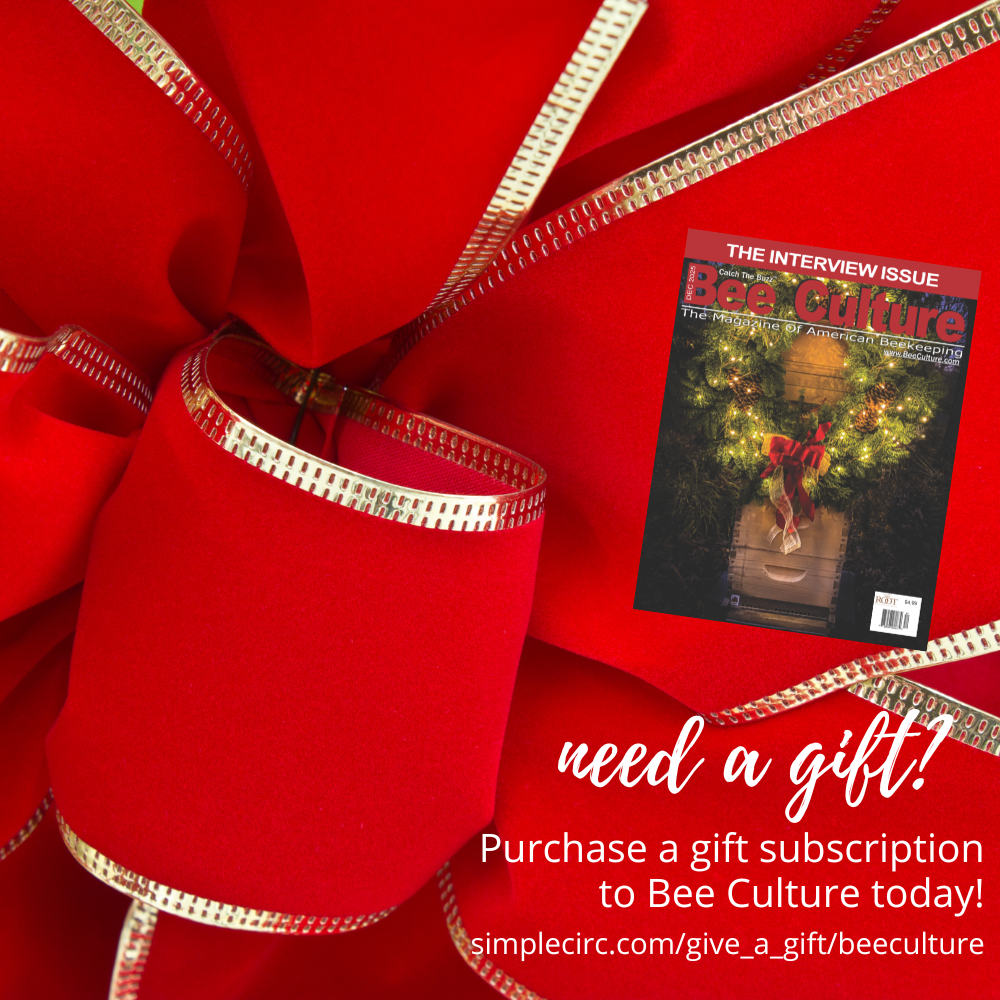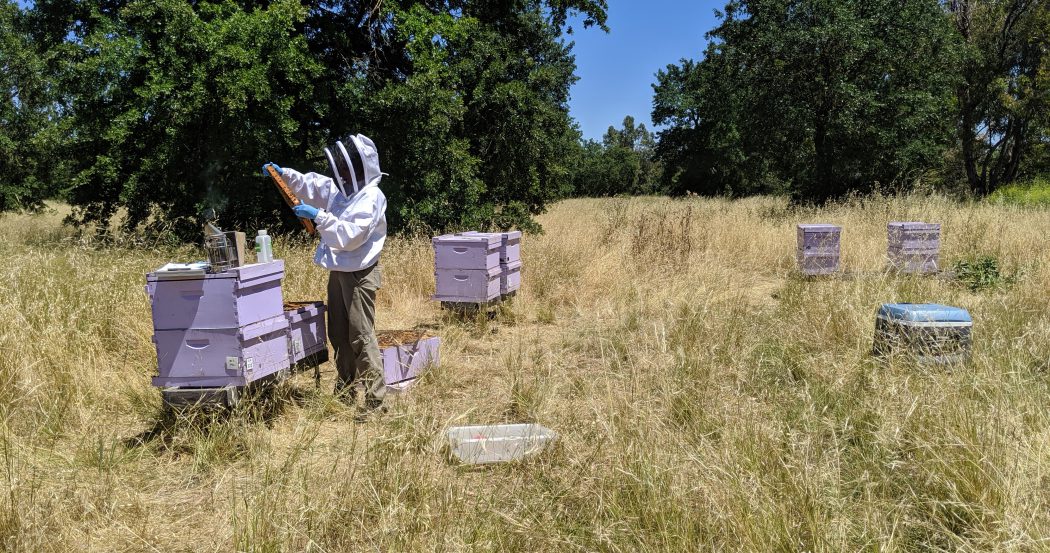The UC Davis Series
By: Elina L. Niño
When I first formed my lab at UC Davis almost ten years ago, as every academic does, I tried to brand myself as a researcher doing X and Y research (in my case it was queen health and reproductive physiology). But the powers that be have decided that I am actually a researcher working on X and Y, but also Z, Q, W, A, B and C. All joking aside, my research goals and lab’s mission have clearly transformed over time to respond to the multifaceted needs of the California beekeepers with hopes that our findings will benefit beekeepers across the U.S. and beyond. When you ask me now what we do, my answer is that the goal and the mission of the Lab is to further our understanding of the stressors affecting honey bees, and more importantly, work towards practical solutions to help support beekeepers and honey bee health. This means that my team at any given moment works on addressing many issues with honey bee pests, pathogens, pesticides, poor nutrition and more recently, environmental stress due to climate change. And we love it this way because there is always something new to learn and explore! In Part 1, we will briefly discuss our work on combating that pesky varroa mite and improving bee health with supplemental forage plantings and nutritional supplements. Part 2 will cover our work on understanding pesticide impacts in California’s agriculture settings and possible solutions, we will discuss our work on determining pollination needs of self-fertile almond varieties, impacts of climate change and air pollution on bee health and wrap up with a study on development of bee sampling techniques to aid veterinarians working with beekeepers. So let’s talk about what we have been up to here in the E. L. Niño Bee Lab.
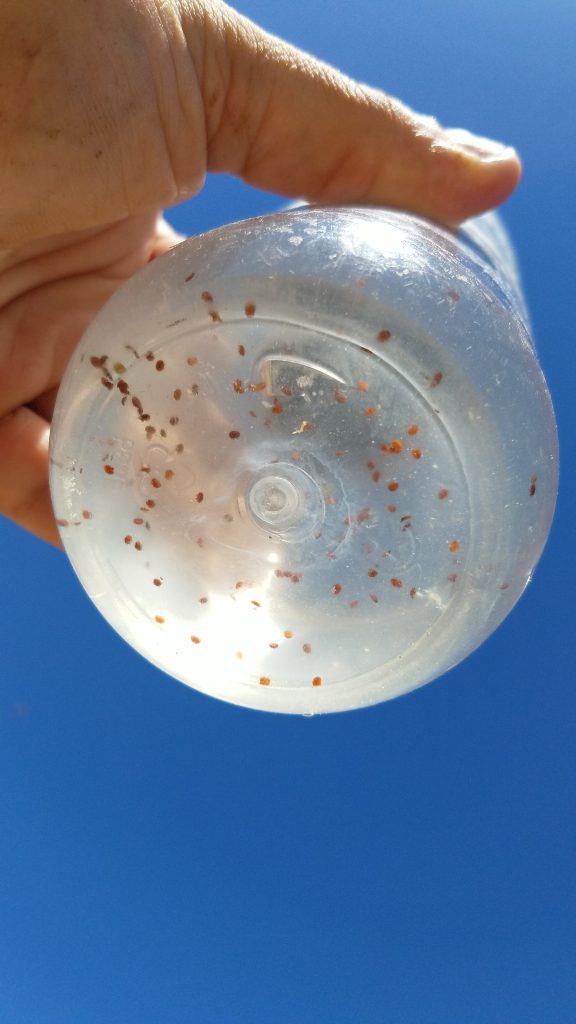
Varroa mite alcohol wash for the control hives in the project testing various varroacides. Photo by B. Nino.
Pests
Probably the number one question I still get asked is: “So what do I do about varroa?!” Parasitic varroa mites (Varroa destructor) remain one of the top stressors beekeepers have to manage in their operations. Thanks to very elegant research by Dr. Samuel Ramsey, now we know that mites feed on bee fat bodies, they can transmit detrimental viruses and can suppress immune activity, making the bees more vulnerable to other stressors. In short, they are very bad news and difficult to manage. Unfortunately, varroa are also pretty good at developing resistance to many of the available miticides. In the recent past, my collaborator (Dr. Lambert Kanga from Florida A&M University) and I have partnered with the IR-4 Project to evaluate and possibly develop novel or modified biopesticides for management of varroa mites. Thus far, we have tested well over a dozen different compounds including entomopathogenic fungi, essential oils, organic acids, bacteriophages (an expertise of Dr. Julianne Grose, Brigham Young University), etc.
What have we learned so far? Well, it is very complicated and time consuming to bring a fully developed and effective product to market, and there are many challenges facing researchers attempting to do so. Remember, we were just evaluating products in almost a final phase so you can only imagine the challenges that are encountered by my colleagues before this point. Other things we have learned is that just because a product works well in the laboratory setting in a Petri dish, it doesn’t mean that success will translate to the field (Surprise, surprise!). Environmental conditions can also be a factor in determining the effectiveness of a product – for example, the entomopathogenic fungi tested worked fairly well in a humid Florida environment but not so much in the very dry Northern California. Dosage, product stability and application methods are another aspect of the product development that determine its success. As we know, beekeepers are busy people and a product that is quick and easy to throw inside a colony without the need for frequent reapplication is a must! But it takes a considerable effort to accomplish this. Considering all of this, I am grateful that we have even the few products available to us. Despite the challenges, these were very valuable experiences that will help improve the future product development. And yes, one of the evaluated reformulated products made it to the market, so I am going to consider that a win.
In addition to varroacides, beekeepers and researchers are very invested in breeding pest (and pathogen) resistant/tolerant honey bee lines as a long-term, more sustainable solution for managing pests and pathogens. Because I have been asked this question many times, here is your answer in advance. Simply stated, tolerance implies that the organism (in this case a honey bee) has developed alternative mechanisms allowing it to succeed despite the presence of a particular stressor, while resistance means that the organism has developed mechanisms to keep the stressor at low or no levels. Over time, there have been a number of breeding programs that have succeeded in developing different lines of honey bees available to the beekeeping industry. These different lines have been selected for characteristics appealing to beekeepers including pest, pathogen tolerance/resistance, quick early Spring build up, Winter hardiness, gentleness and in some cases even color, etc. However, there has been a lack of direct comparison and characterization of these stocks within different environments. My doctoral student Lauren Gregory Rusert, is interested in addressing this particular question in order to be able to make better recommendations to beekeepers based on their own operational interests and goals. Over the past few years she evaluated six different honey bee stocks for their performance in terms of productivity, pest and pathogen levels and survivorship within Northern California apiaries. She is currently writing a final manuscript from this project, but in summary her data reveal that while most stocks have managed to keep varroa mites somewhat in check, there were a couple that performed a bit better. However, the mite pressure in our area has been very high that at some point even the best performing stocks needed help from the miticides. Stay tuned for the rest of the story as Lauren is working hard to publish this data very soon, and use the information for practical incorporation in apiary operations based on the needs of specific beekeepers.
Nutrition
Within the past few years, I also initiated research in areas very new to my lab group, but highly valuable to relevant stakeholder groups. These projects have an overarching theme of helping to mitigate issues facing managed honey bees by improving nutrition. I have been fortunate enough to partner with some wonderful and creative collaborators from my own University (Dr. Neal Williams, you will have an opportunity to read about all of the amazing research done in his laboratory in the upcoming issues of Bee Culture!), other universities (Dr. Gregor Reid, The University of Western Ontario and Dr. Brendan Daisley, currently at University of Guelph) and USDA-ARS (Dr. Arathi Seshadri)
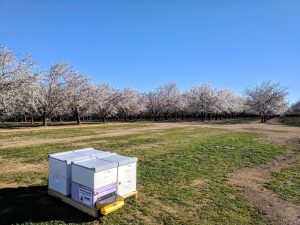
Research colonies in almond orchards with a mounted pollen trap to identify plants the bees foraged on (almonds versus supplemental forage)
As we very well understand now, the best nutrition is provided by the natural forage that the bees can access while out on their foraging trips. The very first study concerning nutrition evaluated two different supplemental forage plantings (mustard mix by Project Apis m and wildflower mix developed by the Williams lab group) for their impact on short and long-term colony health and survival. Almonds in California bloom early in the year, around mid-February, when there is not much else around for bees to eat, but we know that the diverse nutritional sources have benefits for bee health. This is why there has been a great push by researchers, beekeepers and non-profit organizations to incorporate supplemental forage plantings within or at the borders of almond orchards. Despite some weather challenges, we completed two years of the project. Our results further confirm that the proximate benefit of supplemental forage is the improved growth of the colony by improved brood production and therefore higher adult workforce. In this project, we did not confirm the impact on almond yield, however, we can postulate that increased brood production leads to increased foraging and therefore possibly increased pollination efficiency. Interestingly, and perhaps most relevant to the beekeepers, our results suggest that access to supplemental forage has long-term benefits for colony size and survival with colonies having higher overall number of frames of bees going into Winter when having access to specifically mustard plantings during almond bloom. We are currently working on this manuscript so make sure to look us up on Google Scholar. All of our research articles are published as Open Access so you do not have to pay to read our research findings!
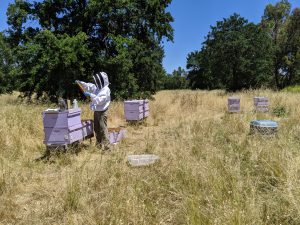
Staff evaluating colonies for the project testing probiotics impact on colony health.
Despite all the benefits of natural forage, habitat degradation, climate change and reduced access to natural areas, make it so the beekeepers more often than not have to provide supplemental feed to ensure colony survival. While macronutrients, such as proteins and carbohydrates, are the main focus, beekeepers are seeking to provide a more complete nutrition via supplements such as probiotics or phytochemicals. Drs. Reid and Daisley have developed a probiotic supplement (a three Lactobacillus spp. complex) that has shown to suppress Paenibacillus larvae, the causative agent of American Foulbrood in the laboratory and preliminary field studies. Naturally, we wanted to test the impact of this probiotic supplement on overall colony health and productivity, when applied either via protein patty or sprayed directly on brood frames. Our results suggest that probiotics used within a protein supplement increase colony strength and honey production and reduce an infection with Nosema spp. as compared to pollen patty alone. Interestingly, we found that application via spray has an impact on bacterial and fungal communities within the exposed bees with potential inhibitive implications for known honey bee pathogens. This work has been published and if you would like to learn more about it, I invite you to visit: https://www.nature.com/articles/s41396-023-01422-z. A pretty cool side note, while processing the samples for this project, Dr. Daisley identified a novel bacterial genus within the honey bee gut. The manuscript has been submitted for publication so stay on the lookout.
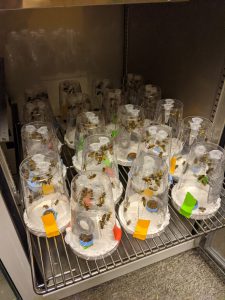
Caged bees fed phytochemcials and observed for survival and hypopharyngeal gland development.
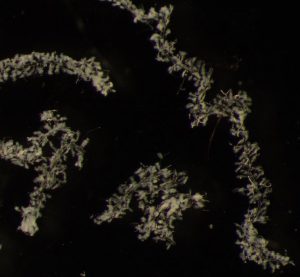
Underdeveloped hypopharyngeal glands from bees in the phytochemicals experiment. Photo by S. Yokota.
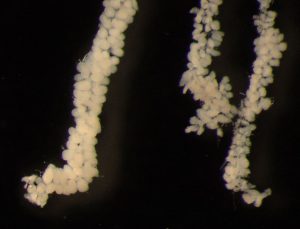
Well developed hypopharyngeal glands from bees in the phytochemicals experiment. Photo by S. Yokota.
Along with probiotics, the use of phytochemicals to improve colony health has garnered attention from beekeepers. While the name sounds intimidating, phytochemicals are simply compounds naturally produced by plants and usually garner some sort of protection to the plant. These are collected by bees when foraging on pollen and nectar. My collaborator Dr. Arathi (USDA-ARS) has reported on the benefits of several of these phytochemicals on Nosema loads and bee survivorship in cages. We then wanted to evaluate several phytochemicals (caffeine, p-coumaric acid, gallic acid and kaempferol) for their impact on bee’s physiological parameters. We found that in a cage study, young worker bees when provided specifically p-coumaric acid had larger hypopharyngeal glands which produce secretions used to feed developing brood. You can read more about this research here: https://www.cell.com/heliyon/pdf/S2405-8440(22)01740-6.pdf. Our data lead us to think that some of these phytochemicals have the potential to improve colony growth and productivity, particularly during stressful times. But, as we learned before, just because something is effective in a lab, does not mean it will work in the field. A pilot field study did suggest that some of these compounds might improve colony longevity. Currently, we are expanding this project to better understand the potential value of these phytochemicals as a feed supplement. The field project is ongoing and is led by Richard Martinez, a Masters student in my lab.
I cannot finish this article without acknowledging the many funding sources supporting this work including USDA, USDA-ARS, Project Apis m, California State Beekeepers Association and many private donors. And we all know that the work wouldn’t be done without the dedication of many excellent students, lab assistant, postdocs and volunteers (Thank you all!). And for those reading, please come back to learn more about our research in Part 2!

